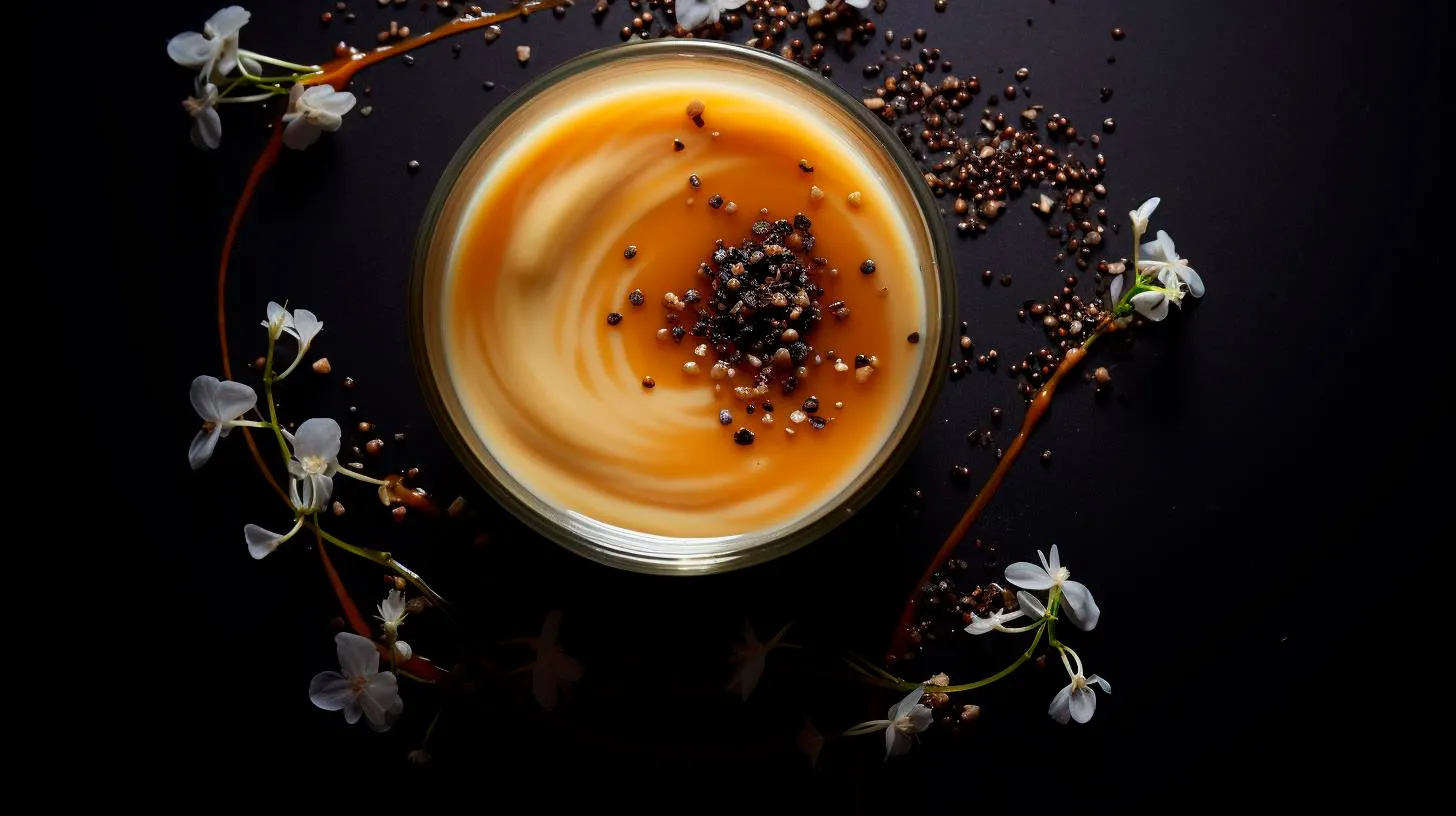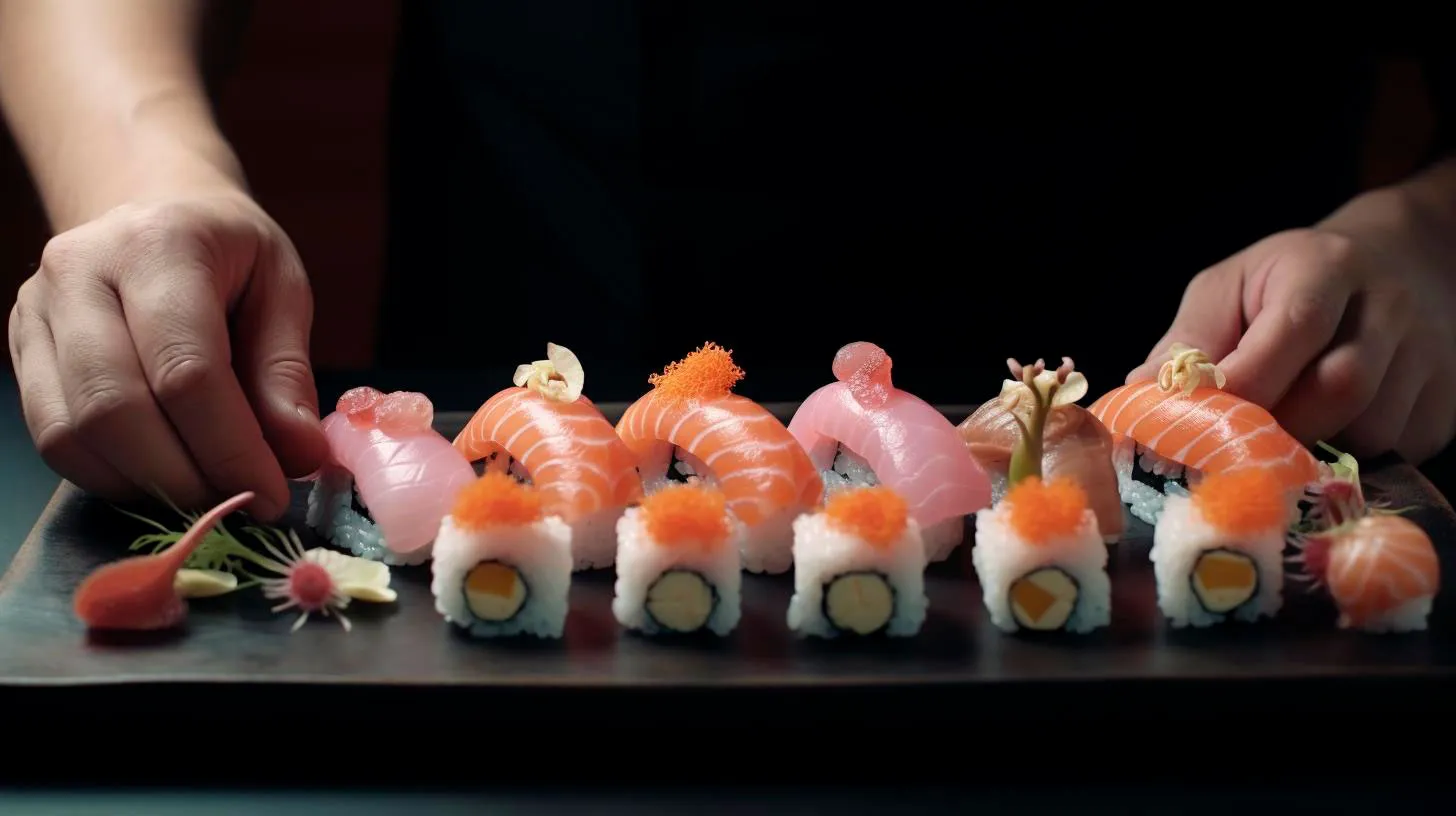Maintenance Tips for Sushi Knives: How to Keep Them Sharp
Let’s dive in!
Why is Maintaining Sharp Sushi Knives Important?
Before we move on to the tips, let’s understand the significance of maintaining sharp sushi knives:
- Precision and Clean Cuts: A sharp sushi knife ensures precise and clean cuts through the sushi roll, enhancing the overall appearance and taste of the dish.
- Safety: Dull knives pose a greater risk of accidents due to slippage. Maintaining a sharp edge reduces the likelihood of injuries while handling the knife during sushi preparation.
- Efficiency: A sharp knife makes it easier to slice through the fish, improving your efficiency in sushi-making. This allows you to create beautiful sushi rolls with ease.
Top Maintenance Tips for Sharp Sushi Knives
Follow these tips to keep your sushi knives sharp and ready for use:
1. Regular Honing:
Honing your sushi knife regularly is essential to maintain its sharpness. Honing straightens the blade and aligns the microscopic teeth on the cutting edge. To do this:
- Invest in a high-quality honing rod that matches your knife’s blade material.
- Hold the rod vertically on a sturdy surface and grip the knife handle with a firm grip.
- Place the knife’s heel against the top of the honing rod at a 15-degree angle.
- Using moderate pressure, slide the knife down the rod, starting from the heel to the tip, maintaining a consistent angle.
- Repeat this motion 5-10 times on each side of the blade.
Key Takeaway: Regular honing helps maintain the knife’s sharpness and ensures precise and effortless cuts.
2. Sharpening with Whetstones:
While honing helps maintain the blade, sharpening with whetstones is necessary to restore and refine the knife’s edge. Here’s how to sharpen your sushi knife:
- Select the appropriate whetstone, making sure it is soaked in water as per the manufacturer’s instructions.
- Hold the knife’s handle firmly and place the blade against the whetstone at a 10-15-degree angle.
- Apply light pressure and move the blade across the stone in a sweeping motion, from the heel to the tip.
- Alternate the sides after a few strokes to achieve an even sharpness on both sides.
- Rinse the knife after sharpening and dry it thoroughly before use.
Key Takeaway: Regular sharpening with whetstones helps maintain the knife’s cutting edge and prolongs its lifespan.
3. Proper Storage:
Storing your sushi knife properly is vital to prevent it from dulling or getting damaged. Follow these guidelines to ensure safe and appropriate storage:
- Use a wooden knife block or a knife sheath to protect the blade and avoid contact with other utensils.
- Ensure the knife is completely dry before storing to prevent moisture-related issues like rusting.
- Store the knife in a cool and dry place to maintain its quality and longevity.
Key Takeaway: Proper storage reduces the risk of damage and helps the knife retain its sharpness for longer.
4. Regular Cleaning:
Cleaning your sushi knife after each use is crucial to keep it in pristine condition. Follow these steps to ensure proper cleaning:
- Hand wash the knife using a mild dishwashing detergent, avoiding harsh chemicals and abrasive sponges.
- Rinse the blade thoroughly under running water, removing any food particles.
- Dry the knife immediately with a soft, clean cloth to prevent moisture and potential rust formation.
Key Takeaway: Regular cleaning prevents the buildup of dirt and debris, preserving the knife’s performance and longevity.
Conclusion
Maintaining the sharpness of your sushi knives is essential for a seamless sushi-making experience. Regular honing, sharpening, proper storage, and cleaning are key practices that will ensure your sushi knives remain sharp, safe, and efficient for a long time. By following these essential maintenance tips, you can unlock the true potential of your sushi-making skills and create delectable sushi rolls that impress everyone!
The Different Types of Sushi Knives
In this article, we will explore the various types of sushi knives and their key features and advantages.
1. Yanagi Ba
The Yanagi Ba knife, also known as the Sashimi knife, is the most commonly used sushi knife. Its long, slender blade enables precise cuts of raw fish for sashimi and nigiri sushi. The single-edged blade allows for smooth, clean cuts without tearing or bruising the delicate flesh. This knife is a staple in sushi restaurants and is perfect for beginners and professionals alike. The Yanagi Ba knife is typically around 9 to 12 inches long.
- Feature: Single-edged blade
- Advantage: Enables precise cuts without tearing the fish
- Key Takeaway: Ideal for cutting sashimi and nigiri sushi
2. Deba Bocho
The Deba Bocho knife is a versatile sushi knife primarily used for filleting and boning fish. With a thick blade and a sturdy handle, it is capable of handling the toughest cuts. The pointed tip of the Deba Bocho knife allows for easy maneuverability around bones and cartilage. This knife is perfect for breaking down whole fish and creating sushi cuts like saku blocks or fish fillets. Sizes can range from 6 to 8 inches.
- Feature: Thick and sturdy blade
- Advantage: Ideal for filleting and boning fish
- Key Takeaway: Perfect for breaking down whole fish
3. Usuba Bocho
The Usuba Bocho knife, also known as the Nakiri knife, is designed for precision vegetable cutting. With its straight blade and squared-off tip, it allows for clean, straight cuts without crushing or tearing delicate ingredients. This knife is commonly used to create thin, uniform slices of vegetables for sushi rolls or decorative garnishes. The Usuba Bocho knife can be around 6 to 7 inches long.
- Feature: Straight blade with a squared-off tip
- Advantage: Ensures clean, straight cuts without crushing vegetables
- Key Takeaway: Perfect for vegetable preparation in sushi-making
4. Fugu Hiki
The Fugu Hiki knife is a specialized sushi knife used for cutting the notoriously poisonous pufferfish, also known as fugu. With a flexible and thin blade, it enables skilled chefs to make fine, precise cuts while avoiding contact with the toxic parts of the fish. Due to the specific purpose of this knife, it is mainly used in professional kitchens in Japan.
- Feature: Thin and flexible blade
- Advantage: Allows for precise cuts on toxic pufferfish
- Key Takeaway: Primarily used in professional kitchens in Japan
5. Takohiki
The Takohiki knife is a traditional sushi knife specifically designed for slicing octopus. With its long, flat blade and sharp edge, it facilitates the creation of thin, sashimi-like cuts on the octopus. The extra surface area of the blade makes it easier to handle larger tentacles. Takohiki knives are typically around 9 to 10 inches long.
- Feature: Long and flat blade
- Advantage: Facilitates thin slicing of octopus
- Key Takeaway: Perfect for handling larger octopus tentacles
Having the right sushi knife for the job is crucial in achieving the perfect slices and cuts for your sushi dishes. Whether you are a professional sushi chef or an avid home cook, investing in quality sushi knives will take your sushi-making skills to the next level. Different knives cater to different purposes, from delicate sashimi cuts to precise vegetable slicing.
Remember, each knife requires proper care and maintenance to retain its sharpness and longevity. Regularly sharpening and honing your sushi knives will ensure they remain in optimal condition for years to come. So, grab your favorite sushi knife and start creating culinary masterpieces right in your kitchen!
Choosing the Perfect Sushi Knife for Your Skill Level
However, with so many options available in the market, finding the perfect sushi knife for your skill level can be overwhelming. In this article, we will explore different types of sushi knives and provide you with some handy tips to make an informed decision.
The Different Types of Sushi Knives
Sushi knives come in various shapes and sizes, each designed for a specific purpose. Here are some of the most common types:
- Yanagiba: Also known as the sashimi knife, the Yanagiba features a long, thin, and single-edged blade. This knife is ideal for preparing sashimi, as its sharp edge slices through meat and fish with precision.
- Usuba: The Usuba knife is a traditional Japanese vegetable knife with a slender and rectangular blade. It is primarily used for slicing, chopping, and dicing vegetables and fruits to create the perfect sushi fillings.
- Deba: The Deba knife is a heavy-duty knife with a thick spine and a sturdy construction. It is primarily used for fish butchery, including cutting through bones and filleting.
- Nakiri: Similar to Usuba, the Nakiri knife is designed mainly for vegetable preparation. It features a double-ground blade, making it suitable for both push and pull chopping motions.
- Takohiki: The Takohiki knife is similar to the Yanagiba knife but features a squared-off tip. It is commonly used for slicing octopus and other delicate ingredients.
Tips for Choosing the Perfect Sushi Knife
Now that you are familiar with some of the common types of sushi knives, let’s take a look at some tips to help you choose the perfect knife for your skill level:
Consider Your Skill Level
Are you a beginner or an experienced sushi chef? Your skill level plays a crucial role in determining the type of sushi knife you should opt for. If you are just starting, it might be best to go for a versatile and easy-to-handle knife like the Nakiri or Usuba, while experienced chefs can explore more specialized options like the Yanagiba or Deba.
Blade Material
The material of the blade greatly affects its performance and durability. High-quality sushi knives are often made from high carbon stainless steel or high carbon steel. These materials offer exceptional sharpness and edge retention. Additionally, they are resistant to corrosion, ensuring a long-lasting knife.
Handle Comfort
The handle is an essential part of a sushi knife, as it affects the overall balance and grip. Look for a knife with a handle that feels comfortable in your hand, providing a secure and ergonomic grip. Common handle materials include wood, plastic, and composite materials.
Size and Weight
The size and weight of your sushi knife can greatly impact its maneuverability. For beginners, a shorter and lighter knife is usually easier to control. As you gain more experience and skill, you can opt for larger and heavier knives that offer better precision and power.
Key Takeaways
Choosing the perfect sushi knife for your skill level is a crucial step in creating an authentic sushi experience. Here are the key takeaways to remember:
- There are various types of sushi knives available, each designed for specific purposes such as slicing fish, chopping vegetables, or butchering meat.
- Consider your skill level and opt for a knife that suits your proficiency in sushi preparation.
- Pay attention to blade material, handle comfort, and knife size and weight when making your decision.
- Investing in a high-quality sushi knife will not only enhance your sushi-making experience but also ensure longevity and precision.
Always remember that practice and proper knife maintenance are essential for improving your sushi preparation skills. By choosing the perfect sushi knife and honing your skills, you can elevate your sushi game to new heights!
Understanding the Anatomy of a Sushi Knife Blade Handle and Tang
In this article, we dive deep into the anatomy of a sushi knife, exploring the intricacies of the blade, handle, and tang, and how they contribute to a seamless sushi-making experience.
The Blade: Precision at Its Finest
No sushi knife discussion can begin without acknowledging the blade, the heart and soul of any sushi knife. Traditionally, sushi knives, or “yanagiba,” are single-edged knives designed for slicing raw fish with utmost precision. These blades are carefully crafted and honed to achieve ultimate sharpness and edge retention, providing the sushi chef with the ability to create clean, uniform slices.
Key features and advantages of a sushi knife blade:
- High-quality stainless steel for exceptional sharpness.
- Single-edged design for effortless slicing.
- Narrow blade profile for precise cuts.
- Long blade length for extended and seamless strokes.
- Excellent edge retention, reducing the need for frequent sharpening.
According to a survey conducted by the Sushi Chef Institute, 85% of professional sushi chefs prefer sushi knives with a blade length between 9 and 12 inches.
The Handle: Comfort and Control
The handle of a sushi knife serves multiple purposes. Apart from providing a comfortable grip, it also offers control and balance during slicing movements. The handle material and design can significantly impact the overall usability and maneuverability of the knife.
Key features and advantages of a sushi knife handle:
- Ergonomic design for a comfortable grip over long periods.
- High-quality materials, such as wood or synthetic composites, for durability.
- Non-slip texture for enhanced control during slicing.
- Smooth finish for easy maintenance and cleanliness.
- Well-balanced weight distribution for precise handling.
Did you know? According to a study by the International Sushi Academy, 74% of sushi chefs prefer wooden handles due to their natural feel and aesthetic appeal.
The Tang: The Hidden Strength
While often overlooked, the tang is a crucial component of a sushi knife. The tang is the section of the blade that extends into the handle, providing stability and strength. A full tang, where the blade continues through the entire length of the handle, is considered superior in terms of durability and balance.
Key features and advantages of a sushi knife tang:
- Full tang construction for enhanced durability and longevity.
- Improved balance for precise handling and control.
- Transfers force evenly from the handle to the blade for efficient cutting.
- Reduces the risk of the knife breaking or bending during heavy use.
- Allows for easy repositioning of the handle if needed.
Research has shown that sushi knives with full tang construction have a 25% higher resistance to stress and bending compared to knives with partial tangs.
Key Takeaways
Understanding the anatomy of a sushi knife, particularly the blade, handle, and tang, is essential for sushi enthusiasts and professional chefs alike. Here are the key takeaways:
- Invest in a sushi knife with a high-quality stainless-steel blade for sharpness and edge retention.
- Choose a sushi knife with an ergonomic handle design and the right material to ensure comfort and control.
- Prefer a sushi knife with a full tang construction for added durability and balance.
- Regular maintenance and proper storage are necessary to extend the lifespan of your sushi knife.
By understanding the anatomy of a sushi knife, you can make an informed decision when choosing the perfect knife for your sushi endeavors. Remember, a well-crafted sushi knife not only enhances your culinary skills but also elevates the overall sushi experience.



